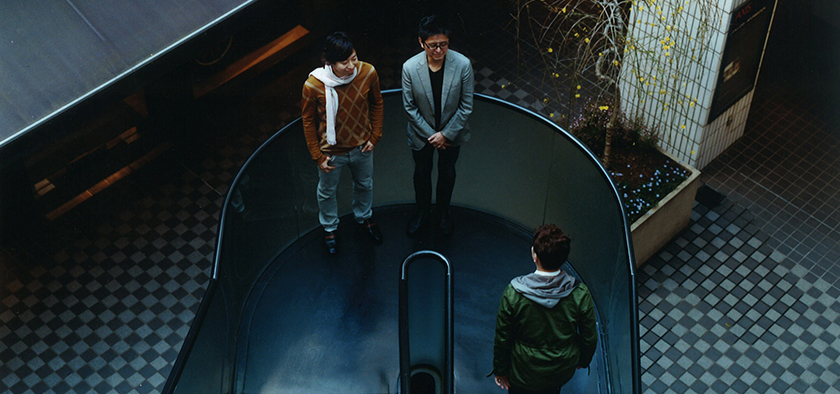
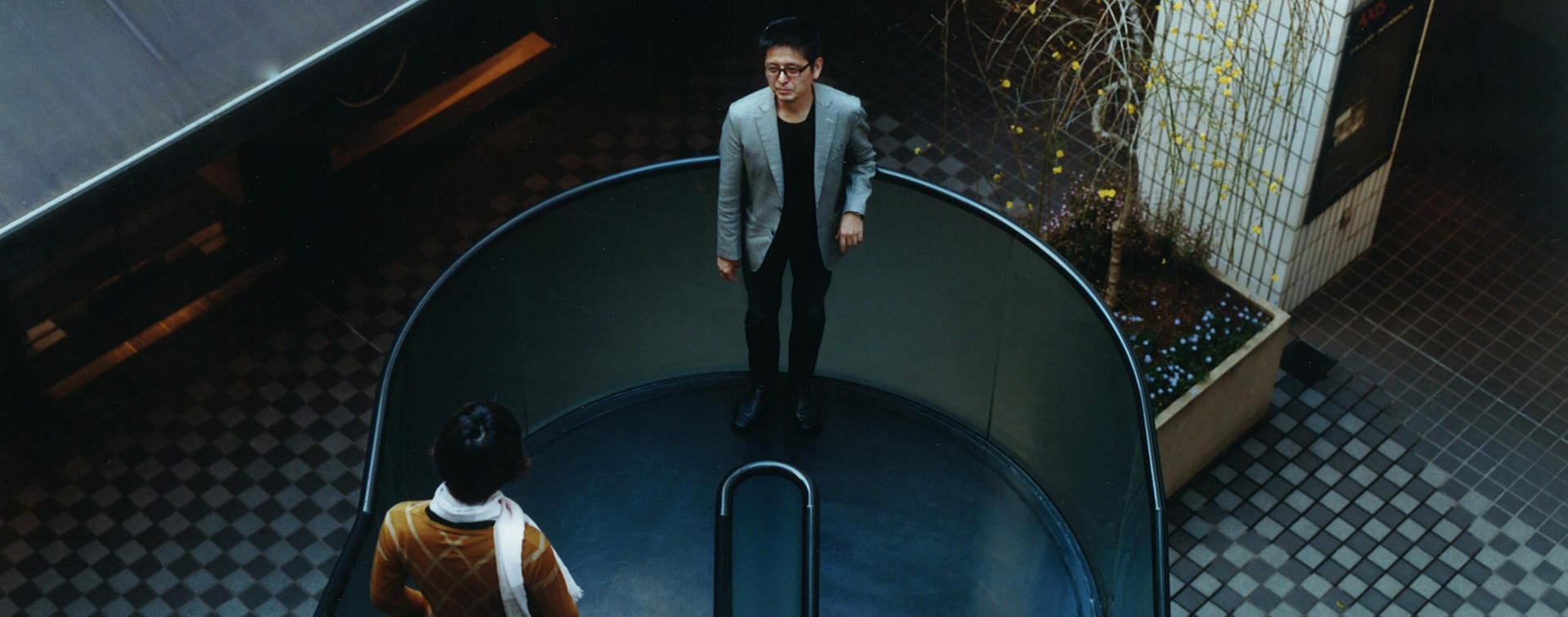
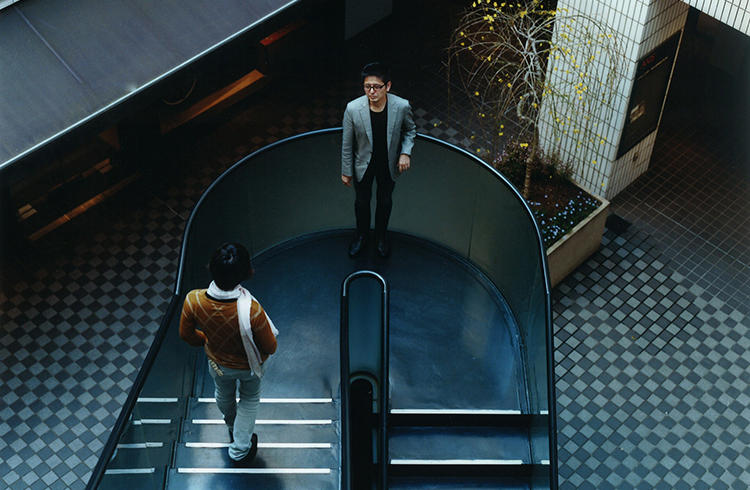
How would you turn Roppongi into an area of Design & Art?
Hold dialogues between the opposite of duality(Watanabe/takram) Pay attention to the blurry feeling(Ishibashi/AXIS) The people in Roppongi take an interest in each other(Tanaka/IDEO)
"Collective Dialogue" is a creative session sponsored by three companies - AIXS, IDEO, takram - which has been launched with the aim of looking at designs not as an objective but as a means. The subtitle of the session is "Power of designs for society's challenges". The first workshop was held in the AXIS Gallery at Roppongi. The three people we interviewed are all central members for this new project. We began by asking what this "Collective Dialogue" is and how it can help us come up with ideas for the future.
Workshops, picnics and...
Kotaro Watanabe (takram) As its name suggests, "Collective Dialogue" is a platform about collectiveness; it's where many different people come together and everyone gives ideas to help solve all kinds of problems. The first event was held in the form of a workshop and drew 36 people. Before the event, we posed this question to the participants: "What community do you belong to?" and then we asked the participants to bring an object symbolizing that community.
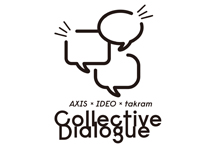
Collective Dialogue
From students to working people, the event draws people from many age groups and a wide range of professions, and aims to provide solutions for problems in Japanese society through group dialogue.
There was an architect who brought a ruler and a city council member who brought a council badge. There was also a woman living in a high-rise condominium who brought a sticker given to all the condominium residents. When all the objects were lined up, we saw that there were so many units of communities. Then we looked at a problem in one of those communities, and began to think about how it could be solved, looking at it from multiple perspectives.
It was not an event for design but an event for people who are interested in using design as a tool. In other words, it was an event aimed to be useful for society, and we also got together people whose jobs are not related to design. We invited House of Councilors member Kan Suzuki-san as a guest because when thinking about solutions for social problems, he is a person who can discuss things from a wide perspective.
Suzuki-san is concerned that a lot of things in the world have not yet progressed from the "kindai" (modern age). So one of the themes that occupies Suzuki-san's mind is how we can graduate from "kindai." At the 3-party meeting with Suzuki-san before the event, he told us that an event where a topic is predetermined and where a guest makes a keynote speech in a one-sided way is symbolic of "kindai". That's why we did not decide on what we would talk about beforehand. The significant point about the first event is that we began by just getting together and then started looking for the problems which are on people's minds.
Kaoru Tanaka (IDEO)The method we took in the first event will not necessarily become the norm. Next time, we might change the style, or we might not say who the guest will be. For example, for the next event, we could just decide on "Roppongi" as the theme. The participants would then imagine that if the theme is Roppongi, the guest might be someone involved in design. But if a farmer were invited as a guest, it would go against people's expectations in a good way and make things interesting. I think when someone you did not expect - someone you did not think of at all - comes along and you spend time with them, it's easier to chat to them and listen to them (than with someone you were expecting.)
WatanabeThe important thing is to use design as a means to solve social problems, and the event itself can take any shape. It would be okay for everyone to watch a movie, for example, or to hold a presentation event like TED, or perhaps on a fine day, have a picnic in Roppongi.
Awareness leads to a blurry feeling
Katsutoshi Ishibashi (AXIS) Having held the first event, I realize that there's not much meaning in discussing whether having awareness of a certain problem is good or bad. It's the same when discussing Roppongi. There are people who say that the "night town" atmosphere of Roppongi isn't good, but it's a fact that there is a night world in Roppongi. That aspect can't be denied and I wouldn't even try saying no to that. The more we deny something, the more people would want to say "is it really that bad?"
TanakaI think you become conscious of communities when you meet people with values and awareness of problems that are different from yours. That's when you realize what kind of person you are yourself. In your normal everyday life, you are not fully conscious of that; you can become conscious of it by reading books or watching the news and using your imagination, but the fastest way is to meet people. For instance, when you meet someone who wants to help a woman having problems with a night job, you become aware that such problems existed. When that awareness comes, you get this blurry feeling.
IshibashiYes, it feels nice when you get the blurry feeling. It is like to keep asking questions without getting clear answers and have a feeling that something is stuck in your mind. But this blurry feeling sometimes turns into solutions to your problems.
TanakaIt's difficult to explain that blurry feeling, but it's like having something you believed in crumble in your head or trying to say something, but having difficulty finding the right words. But sometimes overcoming that feeling by using hands to create objects or prototype, and not just with words, help contribute in solving problems
Using designs to solve social problems means letting awareness of things become a driving force to do something for the town or for the people - taking the step to make a change. The world would become an interesting place if people, started taking action instead of just talking.
WatanabeThat's so true. I think the blurry feeling is about chaos and confusion. I think it's quite important to preserve that inner state of confusion instead of hurrying to the solutions. The exact same thing can be said of Roppongi where variety of people gather. Instead of approaching it with preconceived notions, we should keep the diversity and chaos of Roppongi as they are, and think of reconstructing things within that framework. I think that's the beauty of incorporating designs into the way we think.

Dialogue between the opposite ends of duality
TanakaIshibashi-san just mentioned that Roppongi has this night world. It's true that there are "catch guys" (young men in the streets who lure customers), but there's also the daytime world in Roppongi. There is diversity, with the people of the shopping district and designers and so on. I think that's where the values are. So if we are going to have Roppongi as the theme for "Collective Dialogue", it would be good if we could do things that are possible specifically because people have gathered in Roppongi. How about, for example, setting up a turret between the Roppongi crossing and the highway and have people gather there? The location is conveniently right in the middle of the town.
WatanabeThe ideal place for a dialogue would be a place that would enhance Roppongi's potential and take advantage of its symbolism for chaos - in the good sense. It would be a place that would expand the town's dual aspects - such as its night and daytime aspects that we were just talking about.
TanakaWell, in that case maybe we could hold gatherings in two places. The dual aspects could be daytime and nighttime, but we could also think of the two opposite points as being the sky and the underground. Perhaps we could hold one meeting at the top of the Mori Tower and another on the lowest platform of the Roppongi subway station on the Toei Oedo Line.
IshibashiAnother good place might be the Grass Square at Tokyo Midtown where sometimes the outdoor Café is. I think there are many other good places to meet.

Roppongi subway station on the Toei Oedo Line
Opened in 1991, this station is a subway station on the lowest ground in Japan. Before the name Toei Oedo Line was adopted, there was a proposal to call the station "Yume Mogura" (Dream Mole)
Talking to the "catch guys"
TanakaAt IDEO, where I belong, we often do research, observing people in the street for their behaviors and asking them about their views. This is because we place an importance on human-centered designs. The thought just came to me that if the theme were Roppongi, I would very much like to interview the "catch guys."
IshibashiThat's a good idea - having a proper talk with them in the daytime.
TanakaI would like to know what they think of the town of Roppongi. Maybe they are thinking that the streets should be demarcated. If we talk to them in broad daylight, perhaps we will discover that they are more serious-minded than we thought. Some of the "catch guys" are from Turkey and Africa.
IshibashiThey are important people to do a research on. I too am interested to know what their thoughts are.
TanakaThey have been a long time in Roppongi and get to meet people of all types. If we could listen to what they have to say, and make teams and hold events such as workshops, maybe our view of Roppongi will change.
IshibashiIt would be interesting to hear not only their views on Roppongi, but also about their home countries, the reason why they decide to come to Japan and what they think of Japan and so forth. There must be many hints we could gain by talking to them directly. We would probably be going, "Oh, we didn't know that!" I am also interested in how elementary school and junior high school students in Roppongi think of this area.
TanakaI think the first step in design is to be interested in human beings. It is people that designs are made for. If there is a community, designs are made with the people of the community in mind; designs are always meant for people. So if we are going to think about Roppongi, the first important step is to take an interest in the people in Roppongi.
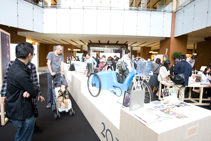
Tokyo Midtown DESIGN TOUCH "Making Dreams Come True" exhibition
A display for IDEO products which was held in Japan for the first time in 2009 at the DESIGN TOUCH Exhibition. The products were made to provide solutions for a wide range of challenges and reflect the designs and ideas created through IDEO's unique process.
Bringing the sense of seasons to Roppong
TanakaI was just thinking about a common topic that we could talk about with the "catch guys". How about "the sense of seasons"? For example, we could plant fruit trees along the road from the Roppongi crossing to Iikura Katamachi. The "catch guys" would look at the trees and say, "It's already the season for fruit to ripen." and the students from Toyo Eiwa University would say, "The fruit look particularly sweet this year." This doesn't sound realistic (laughs), but the sense of seasons is directly linked to designs and creativity, so if that kind of conversation could take place, then Roppongi would become a more stimulating town.
IshibashiThat's a good idea particularly since on this side of Roppongi, there are no places like the Tokyo Midtown Grass Square where you can sense the seasons. In this area, seasonality comes on the Day of Northern Territories on February 7. Around that time, we get the blare from the trucks of right-wing campaigners because the Russian Embassy is nearby. Every year I think, "The ume plum blossoms have fallen. That means it will soon be the Day of Northern Territories. Ah, there's going to be a racket again this year."
TanakaThat seasonality is something you get precisely because you're in Roppongi. I guess it must be a phenomenon with impact.
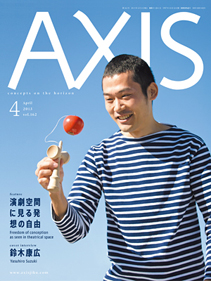
"AXIS" magazine
Launched in 1981 at the same time the AXIS building was opened. Six bimonthly magazines are published every year. The magazine holds information on tangible designs as well as on the role of design in business, communication and culture.
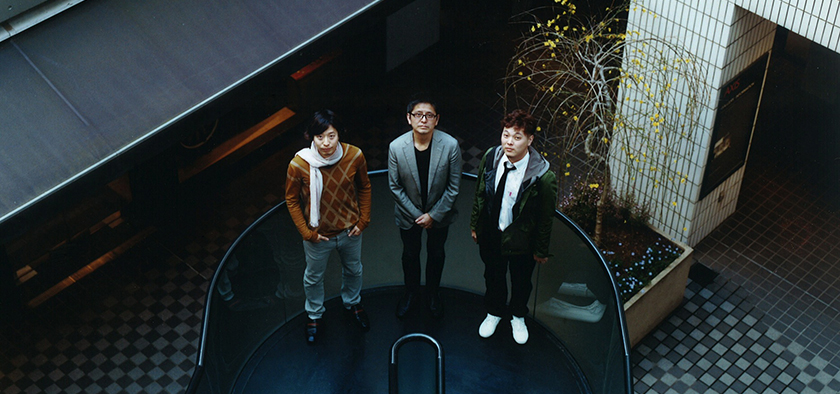
The blurry feeling is a vital aspect of favorite towns
IshibashiOne of towns I am personally curious about is Nakano Broadway. I live nearby. The town has people who are particular about something and people who are a little strange, and when I look at them, I begin to get that blurry feeling. It's not only the people - there are all kinds of shops as well, and walking by them, my mind begins to spin. But I suppose that officially, I should be saying that my favorite town is Ginza. (laughs)
TanakaYou certainly don't get the blurry feeling in Ginza. When I go to the shopping district in Musashi Koyama, I also get the blurry feeling. I like towns where many different individual views and values are mingled, and no one is trying to sort it all out. In Ginza, a framework exists and things are tidied up.
My favorite place is Honolulu. I spent my childhood in Hawaii. There is absolutely no trace of the blurry feeling in Honolulu. But it's nice in its own way; I like the atmosphere of no one doing much thinking. In the town where I lived, there was talk of setting up trains but about 30 years have passed since then. But that's okay. Everyone, young and old, is basically very accepting of people and they have a lot of tolerance. There's a comfortable level of culture too. So when I'm in Honolulu, I don't need to think about what my identity is. (laughs) I also like the West Coast of the United States, and the Bay Area. Those places are also very tolerant. They also have the ability to get things done, and are like the developed version of Hawaii.
WatanabeThere are two favorite cities of mine. One is Tokyo. I like it because its large scale makes it possible for many things to happen at the same time; it also has anonymity and a femme fatale quality that perpetually urges us to pursue but we never get to know the true face. The other city is Stockholm. In contrast to Tokyo, the city's appeal lies in its small size. About three years ago, I lived there for two months. I found that when I go to about two or three events on one evening, it's possible to meet 80% of the art and design community in Stockholm. There are only a small number of hot spots like newly opened bars and restaurants that everyone wants to go to, so the same places are usually continuously used. It's as if something is constantly happening in the same place; a lot of things never happen at the same time in different places. But I think that's kind of cozy and nice in its way. In this atmosphere, we easily come across the people we know on the streets.
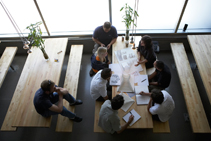
IDEO
A world leader in innovation and design with offices in Palo Alto of Silicon Valley on the US West Coast and 10 other locations worldwide. Involved in human-centered, design-based approach to helping organizations in the public and private sectors innovate and grow. Its Tokyo office is located at Aoyama and used to be located in Roppongi.
© 2007 water project. Photographs by Takashi Mochizuki

furumai
Works shown by takram in 2007 at the Water Exhibition (at 21_21 DESIGN SIGHT). Water drops are placed on plates bearing various designs. By moving the plates, the movement and behavior of water can be enjoyed.
The next design that is not restricted by definition
IshibashiThe thing that interests me in my work is whether there is something else that is going to succeed design, or whether we need another kind of design and what that should be. It's alright to use the word "design" in its broad sense, but we seem to use the "design" to refer to too many things. I don't think that is a good trend. I hope to be able to take unrestricted unique approaches to solve various problems around me.
TanakaAt IDEO, we see design as bigger than just design for designers. We're interested in "creativity." We think that everyone is creative and this is true for Japan and having creative confidence will go a long way in helping identify and launch solutions that solve unmet needs and create maximum impact on the world. Japan has a unique delicateness and sensitivity and we hope we can help to make that creativity blossom so that organizations and individual could change in a positive way.
WatanabeAt my company, we are getting more opportunities to make things with company representatives and executives. So we hope to jointly cultivate thoughts about design with the company management at the same time with the team in charge, and to use that momentum to do all kinds of things. We hope to do more projects that will accelerate the change of the top-down structure of organizations.
Another thing we're interested in is expanding our work beyond making things. I often use the phrase "mutual interaction of making things and the story." I think that the work of designers is essentially like a swan. A swan looks lovely but beneath the water, its legs are moving busily. Working in design is like going back and forth between the two opposites of "the concrete and the abstract" or "chaos and refinement" and reaching a solution. I think the fluctuation between "making things and the story" is included in the work of design. Currently much of our work involves output in tangible things, but in the future, we hope to do more work in designing things that have no tangible form, and are closer to being "stories."
Editor's thoughts
It was the 27th session of the Roppongi Future Talks and the first time for three people to be interviewed. The three guests talked about their own images of Roppongi and I found their views, such as on the well-known (?) "catch guys" of Roppongi and the Roppongi subway station that is deep underground on the Toei Oedo Line, very informative. (edit_rhino)


















